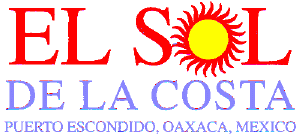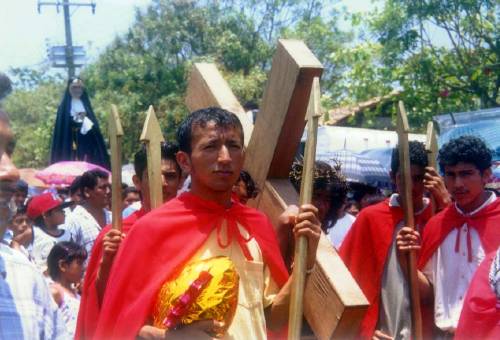

 Semana Santa, "Holy Week", is one of the most important holidays of the
year. It begins April 4, Palm Sunday, and runs through Easter Sunday,
April 11.
Semana Santa, "Holy Week", is one of the most important holidays of the
year. It begins April 4, Palm Sunday, and runs through Easter Sunday,
April 11.
Think of it as a combination of Spring Break ¯ on a massive scale ¯ and Christmas. Like most Mexican religious observances, it is a mix of the sacred and the profane. Somber religious ceremonies mix with uninhibited partying.
It is the single busiest holiday period of the year. All the city folks who are able to, get out of town for the holidays. It is said that utility consumption, water, electricity etc., falls by 30 percent during this period in México City. And the preferred destination, of course, is a beach resort.
Even the nation's most isolated beach destinations are likely to be completely overtaken by large families of campers and day-trippers.
It is a good time to stay off the highways and to just enjoy the community in which you find yourself. Hotel rooms are booked solid, as are planes and buses, and shortages of supplies in the stores and cash at the bank machines are not uncommon.
During this week, the faithful throughout México celebrate with great fervor the last days of Christ on earth. Palm Sunday represents Jesus s triumphal entry into Jerusalem after His 40 days of spiritual reflection and struggle against evil and temptation in the desert (a period that is represented by the observance of Lent).
Processions take place through many of the main streets of most towns along with the blessing of the palms in the parish church.
Thursday and Good Friday of Easter Week are when things reach a peak of activity. During these days most communities hold religious processions and reenactments of events such as the Last Supper and the arrest of Christ and His trial before Herod.
 Some are very elaborate pageants and Passion Plays with costumed
characters representing biblical figures such as Pontius Pilate, the
Virgin Mary and Christ Himself.
Some are very elaborate pageants and Passion Plays with costumed
characters representing biblical figures such as Pontius Pilate, the
Virgin Mary and Christ Himself.
On Good Friday the procession known as El Encuentro, the meeting or encounter, takes place when Mary is reunited with her son during His passage along the Via Doloroso to His crucifixion.
On the Saturday before Easter, Saturday of Glory as it is known here (Sabado de Gloria), in some communities there's some comic relief to the general solemnity with the raucous burning of Los Judas, the Judases. These large papier maché effigies, usually painted in eye-popping colors, represent Judas Iscariot and other forces of evil, Especially prepared by the local cohetero or pirotécnico who creates fireworks for all festive occasions, the figures are hung up in the street or the central town plaza. Once the public has gathered, they are ignited in quick succession and, to the delight of all, are literally blown to bits, thereby symbolizing the triumph of good over evil.
For all Christian churches, Easter Sunday is unquestionably the most important day of the entire religious calendar. Since all Roman Catholics are expected to attend mass and take Holy Communion to mark the holiday, every celebration held in each of the thousands of churches throughout México will be packed with the faithful on this day.
The church bells will ring out to proclaim a day of joy and spiritual renewal, the promise of redemption symbolized by the Resurrection of Jesus Christ.
It is a particularly interesting time to visit one of the nearby indigenous communities to experience the passion and faith of the people expressed in rites and customs that mix both Christian and pre-Hispanic beliefs.
One such place is Santos Reyes Nopala, an attractive hill-top town that is located in the coffee-growing foothills of the Sierra Madre del Sur, where the Chatinos from surrounding communities gather in huge numbers for this Spring celebration.
The area surrounding the town of Pinotepa Nacional with its mix of Mestizos, Mixtec, Amusgo and Chatino Indians and Afro-Mestizo communities also celebrates the season with particularly colorful ritual and pageantry.
Here in Puerto, to ensure that the hordes of visitors have adequate
amusements, there will be lots of nonreligious activities taking place:
carnival rides for the kids, beach festival, cock fights and rodeos
among them.